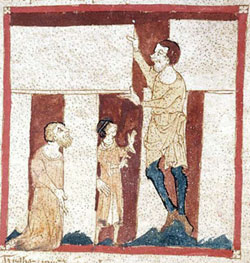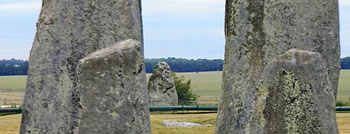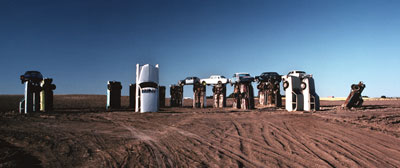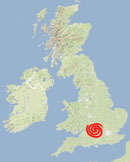03 Aug Stonehenge
“The King…spoke to him about the monument which he was planning. ‘If you want to grace the burial-place of these men with some lasting monument,’ replied Merlin, ‘send for the Giants’ Ring which is on Mount Killaraus in Ireland. In that place there is a stone construction which no man of this period could ever erect, unless he combined great skill and artistry. The stones are enormous and there is no one alive strong enough to move them. If they are placed in position round this site, in the way in which they are erected over there, they will stand for ever.’
…
When the Britons heard all this, they made up their minds to send for the stones and to make war on the people of Ireland if they tried to hold them back. In the end the King’s brother, Utherpendragon, and fifteen thousand men, were chosen to carry out the task…They made ready their ships and they put to sea. The winds were favourable and they arrived in Ireland.”
Geoffrey of Monmouth, The History of the Kings of Britain, c. 1136 1
Stonehenge is located in England, not in Ireland. But that may not always have been the case. According to legend the monument was once situated in Co. Kildare, southwest of Dublin. As explained by Geoffrey of Monmouth (c. 1100 – c. 1155), Merlin the magician moved Stonehenge from Ireland to England to serve as a memorial for the hundreds of Britons treacherously slain by the Saxons during a truce meeting on Salisbury Plain. In this story, which Geoffrey claimed was based on an older work he had found, King Ambrosium Aurelianus (uncle of King Arthur) wanted to build a memorial for his dead warriors which would last forever, but his builders could think of no way of doing it. Merlin provided the solution: go to Ireland and bring back the one that’s there.
According to the story, when the king’s legions arrived in Ireland they were met by Gillomanius, the local ruler, who said,
“‘I am not surprised that a race of cowards has been able to devastate the island of the Britons,’ said he, ‘for the Britons are dolts and fools. Who ever heard of such folly? Surely the stones of Ireland aren’t so much better than those of Britain that our realm has to be invaded for their sake! Arm yourselves, men, and defend your fatherland, for as long as life remains in my body they shall not steal from us the minutest fragment of the Ring.'”
The brave words of Gillomanius were to no avail, as the Irish were soon vanquished in the battle for the Giants’ Ring. But the invading warriors of King Aurelianus proved unable to dismantle the immense stones until Merlin used his magic to assist them. The magician was also called upon when it was time to put together the pieces of what would become Stonehenge on the Salisbury Plains of England across the Irish Sea.
“Aurelius ordered Merlin to erect round the burial place the stones which he had brought from Ireland. Merlin obeyed the King’s orders and put the stones up in a circle round the sepulchre, in exactly the same way as they had been arranged on Mount Killaraus in Ireland, thus proving that his artistry was worth more than any brute strength.”
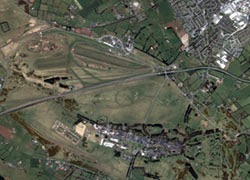
The Curragh of Kildare, which some scholars identify with the “Mount Killaraus” of the Merlin legend. Click to see in Google Maps. ©2011 Google – Imagery ©2011 DigitalGlobe, GeoEye.
Our virtual-reality tour of Stonehenge explores the monument from seven different vantage points. There is also a version of the tour optimized for use in a head-mounted display (HMD), such as Google Cardboard or Oculus Rift, available here. Learn more about HMD VR here.
Many books, thoroughly discredited, have been written asserting that other races and civilizations, from the Phoenicians to the Babylonians, were the ones who built Ireland’s prehistoric monuments. Some of these authors were British aristocrats who may have been, subconsciously or otherwise, expressing their own prejudicial beliefs that the “wild Celts” could not possibly have had the sophistication to create the great passage tombs or the tall round towers entirely on their own. It is ironic, then, for a twelfth century British author to credit the Irish with the origin of this, the most renown of the ancient monuments in England. However, Merlin states that the stones of the Giants’ Ring originally came from Africa. “Many years ago the Giants transported them from the remotest confines of Africa and set them up in Ireland at a time when they inhabited that country.”
Geoffrey’s “history” was accepted as fact and repeated for hundreds of years as the best explanation of the origin of Stonehenge.2 It may have been believed even by some of the more literate folk until as late as the eighteenth century, and by the seventeenth century was noted as a traditional folk belief held by the common people. Thus some folklore may be the “survival among the masses of the outdated beliefs of the educated classes.”3
If the tale of Merlin’s transport of the stones were not fantastic enough, a variant of the story has Merlin enlist the Devil in an attempt to acquire the Irish stones, which “grew in an odd sort of Form in a Backside belonging to an old Woman in Ireland.”4
Can there be any morsel of truth within Geoffrey’s story of Merlin and Stonehenge? Can it be that “history keeps peeping through the fiction?”5 According to nineteenth century Irish cartographer and scholar John O’Donovan, “There is no doubt…that such stones existed in the time of [Geoffrey’s history] either near the Castle of Kildare or that of Naas, but I fear they have been long since destroyed.”6 There is one curious coincidence: when archaeologists in 1923 determined the source of the bluestones of Stonehenge to be the Prescelly Hills in Pembrokeshire, this was directly on the Irish-Wessex trade route.7 Thus it may be that the story of Merlin and the Irish source of the monument may have originated with a story “deeply rooted in tradition”8 of the stones being carried a long distance under the direction of a charismatic leader,9 or that at least the design of Stonehenge was inspired by a monument to the west, across the sea in Ireland.10
In the popular imagination Ireland may have no connection with this, the world’s quintessential megalithic monument. But ever since the eighteenth century Stonehenge and similar monuments were bound up with romantic notions of the Druids. And then, since the 1960s the romance shifted from the Druids to the stars. We’ll consider these in order, beginning with the Druids, the pagan priestly class of the Iron Age in Britain and Ireland.
“There is nothing like it, to my knowledge, in all antiquity; and ’tis an original invention of our Druids, an ingenious contrivance to relax the inner and more sacred part, where they perform’d their religious offices.
…
When you enter the building, whether on foot or horseback and cast your eyes around, upon the yawning ruins, you are struck into an ecstatic reverie, which none can describe, and they only can be sensible of, that feel it.” 11
William Stukeley, Stonehenge, a Temple Restor’d to the British Druids, 1740
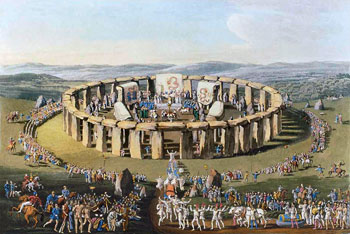
“The Grand Conventional Festival of the Britons,” from The Costume of the Original Inhabitants of the British Islands, by Samuel Meyrick and Charles Smith, 1814.
Dr. William Stukeley (1687-1765), is known for his pioneering methodical fieldwork as an antiquarian, the field from which emerged the modern discipline of archaeology. While engaged in the mid-1720s with his measuring and sketching work at Stonehenge he and some friends formed the “Society of Roman Knights,” for which each member chose a unique heroic-sounding Roman or Celtic name. Stukeley, however, decided to fancy himself a Druid, taking the name Chyndonax.12 He soon became known as the “Arch-Druid.”13 The publication of his major opus on the monument, Stonehenge, a Temple Restor’d to the British Druids (1740), took some 20 years. During that interval Stukeley’s interests switched from objective fieldwork to matters of theology. And by the time the book was published the text was filled with discussions of druids, patriarchal religion, and his views on the rightful successor to God’s original and universal religion.14
“As Stukeley’s ecstasy came to define the right attitude to Stonehenge, so Stukeley’s theories defined its understanding. Every aspect of ancient Britain could be made Druidic…” 15
There is very little in the way of documentary evidence about the historical Druids, who were only briefly mentioned in the Roman chronicles of the conquest of Britain. It was reported that they worshipped in groves of trees and practiced animal (and perhaps human) sacrifice. But to Stukeley and his successors, “…the Druids were the priests of the ancient Britons. Stonehenge was an ancient British temple. A reconciliation between the two had to be effected somehow.”16
The Druids projected by Stukeley came to populate not only Stonehenge but also the entire galaxy of megalithic monuments in England, Ireland, and beyond. Long after anthropologists and archaeologists came to agree to there were no connections between the Druids and the building of these monuments the connection persisted in the public consciousness.17
In the 1920s the inheritors of the Arch-Druid’s legacy had yearly battles against the Office of Works, the government agency charged with protecting the monument, by then in state care.18 Denied free access for their Stonehenge celebrations during the 1926 summer solstice, the Druidic army, led by Dr. George MacGregor Reid, Chief Druid of the Church of the Universal Bond, easily outmatched the platoon of four constables and swarmed over the fences.19
In the modern era the Stonehenge tribe of Druids has blended into an amalgam of Wiccans, neo-Pagans, earth-centered New-Age spiritualist forces, and thousands of other enthusiastic party-goers who each June are allowed to have their solstice fling at the Giant’s Ring.
“Depart central London at 1 a.m. June 21st. Mini Coach Travel to Stonehenge with guide and spend 3 – 4 hours inside the circle and witness the sun rising, Druid Ceremony and festivities. Back to London at 8 a.m.” 20
The first book devoted to Stonehenge was published in 1655, after King James I commissioned his favorite architect Inigo Jones to conduct a serious survey of the site.
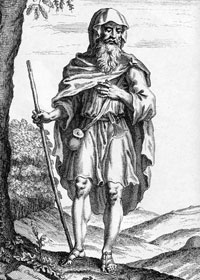
“A British Druid,” from Stonehenge, a Temple Restor’d to the British Druids, William Stukeley, 1740.
In The Most Notable Antiquity of Great Britain, Vulgarly Called Stone-heng, on Salisbury Plain, Restored, Jones concluded that Stonehenge was not all that ancient, being actually a Roman temple devoted to the sky god Coelus. Jones may have intended this to be a justification for his importation of Italian neo-classical architectural design to Britain.21
Even into the twentieth century some authors insisted that the monument was of relatively recent construction. In a 1920 article A. H. Allcroft asks how Stonehenge could possible be thousands of years old when, even by the modern construction standards of his day, nothing could be built that might last that long. “Where is there a church which can be proved to have stood without repair or reconstruction even for the 1300-odd years of Christianity in the United Kingdom? How is it conceivable that mere stones…can have defied the winds, rain, and frosts of immemorial years?”22
Modern-day scientific archaeology, with the ability to accurately date organic finds, has determined that Stonehenge was actually built in three stages, beginning with a circular wooden ring c. 3100 BCE and continuing, with partial dismantling and re-use of stones by peoples of different cultures, until the final construction of the inner circle around 1400 BCE. A visitor to the monument today will find a perimeter ditch and bank, enclosing an outer circle of stones, surrounding another partial circle in the shape of a horseshoe, the signature trilithons, with their lintels, dominating the central area.23 Each phase of construction, along with whatever ceremonies accompanied its completion, were important activities in creating and nourishing the social and political cohesion of the different cultures.24
There were other legends that became attached to Stonehenge over the millennia that it has stood on the Salisbury Plain. From details within the Merlin story it was believed by some that the stones had medicinal properties, that “they washed the stones and poured the water into baths, whereby those who were sick were cured.”25 At the end of the seventeenth century John Aubrey reported that “it is generally averred hereabouts that pieces (or powder) of these stones putt into their Wells doe drive away the Toades, with which their Wells are much infected…”26
In a folk belief attached to many other stone circles both in Britain and in Ireland, it was thought by many that it was not possible to count the number of stones in the circle. The earliest record of this belief may be in a sonnet entitled “The Seven Wonders of England” (1598):
“Neere Wilton sweete, huge heapes of stones are found,
But so confusde, that neither any eye
Can count them just, nor Reason trye,
What force brought them to so unlikely ground.” 27
What the powers of Merlin must have meant to the credibility of a story in the twelfth century may have been transferred to the powers of an IBM 7094 computer in the twentieth century. Gerald Hawkins (Stonehenge Decoded) announced in 1963 that, through the powers of what was then a revolutionary machine intelligence, he had found proof that Stonehenge was a prehistoric calculator. Hawkins asserted that the monument was used by ancient Britons to predict all sorts of celestial events due to the 24 different solar and lunar alignments his computer had discovered. He referred to his discoveries as “the machine’s findings,” and his seemingly irrefutable conclusions, as well as his popular writing style, made his book into a best seller.28 The trade magazine IBM News joined in the celebration of this marriage of ancient stones with modern technology by crowing “Those crazy old Druids may have known what they were doing after all.”29
As Merlin may be a proper symbol for the imaginative powers of a person in the early Middle Ages, and as the Druids may have satisfied the pastoral aspirations of antiquarians in the eighteenth century, the dispassionate but all-knowing computer may best define the modern imagination. Jacquetta Hawkes has noted that “Every age has the Stonehenge it deserves—or desires.”30
After Hawkins’ book appeared, and a later tome by Alexander Thom, noted astronomers and archaeologists lined up to denounce the more far-fetched theories of “archaeoastronomy.”31 In “Moonshine on Stonehenge,“ Professor Richard Atkinson, who excavated the monument from 1950 to 1964, explained how Hawkins found alignments between landscape features and parts of the monument that did not exist at the same time period, and that he used for some of his stone positions holes that were actually the remains of tree roots.32
As computers are now ubiquitous, and the processing power of the IBM 7094 from 1960 is likely contained in last year’s cell phone, the enthusiasm that greeted Stonehenge Decoded seems like a quaint artifact of its time…
“…[in] the decade when space travel was becoming a reality and the computer promised to solve everything “Stonehenge Decoded” dreamed of ‘the actuality of a symbiotic merger’ of electronic and human brains skillfully and beneficially entwined.” 33
Other writers, in particular Erich von Däniken (Chariots of the Gods, 1968) insisted that Stonehenge was created as a navigational beacon to attract ancient astronauts. These theories are considered more fully in the discussion of the Kealkil Stone Circle. Astronomers, archaeologists, as well as the contemporary devotees of Hawkins and Thom can agree that Stonehenge clearly has an alignment at the solstices, when the rising sun appears over the Heel Stone. We may infer that such an orientation was “intended to express a religious symbolism,”34 within the understanding that the monument was intended as a temple, rather than a calculator.
“…it’s clear that they were not stone age Einsteins, but that they were very much preoccupied with rituals involving life, death, fertility, their ancestors, and that this time of midsummer and midwinter that is marked out by the stones of Stonehenge was crucial to their values and beliefs.” 35
Stonehenge represents an uninterrupted tradition of wonder and sacredness for those who visit and for those who experienced it as a part of their native landscape. “…the only certainty about Stonehenge is that the ancient secret it conceals is a formidable one.”36
“Pile of Stone-henge! so proud to hint yet keep
Thy secrets, thou that lov’st to stand and hear
The Plain resounding to the whirlwind’s sweep,
Inmate of lonesome Nature’s endless year.” 37
from William Wordsworth, “Guilt and sorrow; or incidents upon Salisbury Plain,” 1793-94
Click here to see all the notes from this page.
Stonehenge, Salisbury Plain, England
Nearest Town: Salisbury
Latitude: 51° 10′ 43.95″ N
Longitude: 1° 49′ 34.36″ W
External Links:

